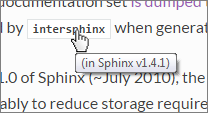Sphinx objects.inv v2 Syntax¶
After decompression, “version 2” Sphinx objects.inv files
follow a syntax that, to the best of this author’s ability to determine,
is completely undocumented. The below
syntax is believed to be accurate as of Jun 2018 (Sphinx v1.7.4).
Based upon a quick git diff of the Sphinx repository, it is thought to be accurate for all
Sphinx versions >=1.0b1 that make use of this “version 2” objects.inv format.
The first line must be exactly:
# Sphinx inventory version 2
The second and third lines must obey the template:
# Project: <project name>
# Version: <full version number>
The above project name and version are used to populate mouseovers for
the intersphinx cross-references:
The fourth line must contain the string ‘zlib’ somewhere in it, but for the purposes of consistency it should be exactly:
# The remainder of this file is compressed using zlib.
All remaining lines of the file are the objects data, each laid out in the following syntax:
{name} {domain}:{role} {priority} {uri} {dispname}
{name}- The object name used when cross-referencing the object (falls between the backticks)
{domain}- The Sphinx domain used when cross-referencing the object (falls between the first and second colons; omitted if using the default domain)
{role}- The Sphinx role used when cross-referencing the object (falls between the second and third colons; or, between the first and second colons if using the default domain)
{priority}- Flag for placement in search results. Most will be 1 (standard priority) or -1 (omit from results)
{uri}- Relative URI for the location to which cross-references will point.
The base URI is taken from the relevant element of the
intersphinx_mappingconfiguration parameter ofconf.py. {dispname}- Default cross-reference text to be displayed in compiled documentation.
Note
The above fields MUST NOT contain spaces,
except for {dispname} which MAY contain them.
For illustration, the following is the entry for the
join() method of the str class in the
Python 3.5 objects.inv, broken out field-by-field:
str.join py:method 1 library/stdtypes.html#$ -
{name} = str.join
{domain} = py
{role} = method
{priority} = 1
{uri} = library/stdtypes.html#$
{dispname} = -
The above illustrates two shorthand notations that were introduced to shrink the size of the inventory file:
- If
{uri}has an anchor (technically a “fragment identifier,” the portion following the#symbol) and the tail of the anchor is identical to{name}, that tail is replaced with$.
- If
{dispname}is identical to{name}, it is stored as-.
Thus, a standard intersphinx reference to this method would take the form (the leading
:py could be omitted if py is the default domain):
:py:meth:`str.join`
The cross-reference would show as str.join() and link to the relative URI:
library/stdtypes.html#str.join
Other intersphinx Syntax Examples
To show as only join():
:py:meth:`~str.join`
To suppress the hyperlink as in str.join():
:py:meth:`!str.join`
To change the cross-reference text and omit the trailing parentheses
as in This is join!:
:py:obj:`This is join! <str.join>`
